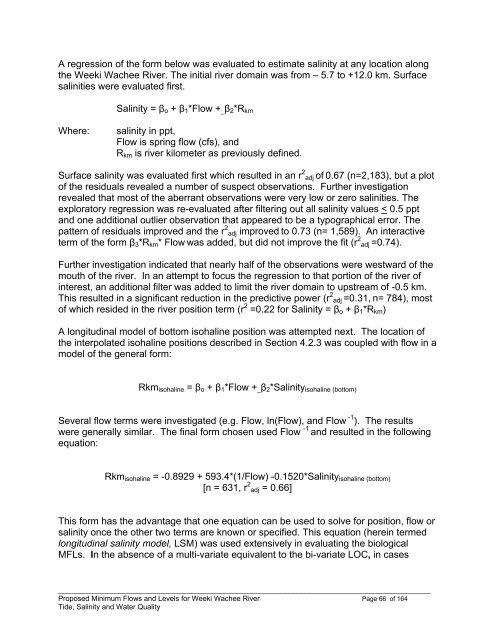Weeki Wachee River System Recommended Minimum Flows and ...
Weeki Wachee River System Recommended Minimum Flows and ...
Weeki Wachee River System Recommended Minimum Flows and ...
You also want an ePaper? Increase the reach of your titles
YUMPU automatically turns print PDFs into web optimized ePapers that Google loves.
A regression of the form below was evaluated to estimate salinity at any location along<br />
the <strong>Weeki</strong> <strong>Wachee</strong> <strong>River</strong>. The initial river domain was from – 5.7 to +12.0 km. Surface<br />
salinities were evaluated first.<br />
Salinity = β o + β 1 *Flow + _ β 2 *R km<br />
Where:<br />
salinity in ppt,<br />
Flow is spring flow (cfs), <strong>and</strong><br />
R km is river kilometer as previously defined.<br />
Surface salinity was evaluated first which resulted in an r 2 adj of 0.67 (n=2,183), but a plot<br />
of the residuals revealed a number of suspect observations. Further investigation<br />
revealed that most of the aberrant observations were very low or zero salinities. The<br />
exploratory regression was re-evaluated after filtering out all salinity values < 0.5 ppt<br />
<strong>and</strong> one additional outlier observation that appeared to be a typographical error. The<br />
pattern of residuals improved <strong>and</strong> the r 2 adj improved to 0.73 (n= 1,589). An interactive<br />
term of the form β 3 *R km * Flow was added, but did not improve the fit (r 2 adj =0.74).<br />
Further investigation indicated that nearly half of the observations were westward of the<br />
mouth of the river. In an attempt to focus the regression to that portion of the river of<br />
interest, an additional filter was added to limit the river domain to upstream of -0.5 km.<br />
This resulted in a significant reduction in the predictive power (r 2 adj =0.31, n= 784), most<br />
of which resided in the river position term (r 2 =0.22 for Salinity = β o + β 1 *R km )<br />
A longitudinal model of bottom isohaline position was attempted next. The location of<br />
the interpolated isohaline positions described in Section 4.2.3 was coupled with flow in a<br />
model of the general form:<br />
Rkm isohaline = β o + β 1 *Flow + _ β 2 *Salinity isohaline (bottom)<br />
Several flow terms were investigated (e.g. Flow, ln(Flow), <strong>and</strong> Flow -1 ). The results<br />
were generally similar. The final form chosen used Flow -1 <strong>and</strong> resulted in the following<br />
equation:<br />
Rkm isohaline = -0.8929 + 593.4*(1/Flow) -0.1520*Salinity isohaline (bottom)<br />
[n = 631, r 2 adj = 0.66]<br />
This form has the advantage that one equation can be used to solve for position, flow or<br />
salinity once the other two terms are known or specified. This equation (herein termed<br />
longitudinal salinity model, LSM) was used extensively in evaluating the biological<br />
MFLs. In the absence of a multi-variate equivalent to the bi-variate LOC, in cases<br />
____________________________________________________________________________________________<br />
Proposed <strong>Minimum</strong> <strong>Flows</strong> <strong>and</strong> Levels for <strong>Weeki</strong> <strong>Wachee</strong> <strong>River</strong> Page 66 of 164<br />
Tide, Salinity <strong>and</strong> Water Quality
















